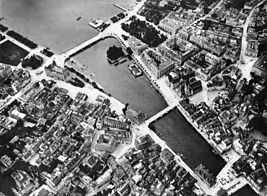Münsterbrücke Zürich
| Münsterbrücke | |
|---|---|
 | |
| Coordinates | 47°22′12″N 8°32′35″E / 47.37000°N 8.54306°ECoordinates: 47°22′12″N 8°32′35″E / 47.37000°N 8.54306°E |
| Carries | one lane for road traffic and pedestrians |
| Crosses | Limmat river |
| Locale | Münsterhof–Limmatquai, Zürich, Switzerland |
| Official name | Münsterbrücke |
| Characteristics | |
| Number of spans | 4 |
| History | |
| Designer | Alois Negrelli |
| Construction begin | 1836 |
| Opened | 1838 |
_-_linkes_Limmatufer_-_M%C3%BCnsterbr%C3%BCcke_2013-04-08_15-19-43.jpg)

Münsterbrücke is a pedestrian and road bridge over the Limmat in the municipality of Zürich in the Canton of Zürich in Switzerland. It is listed in the Swiss inventory of cultural property of national and regional significance. It is indirectly named after the Münster (plural), in fact the two minster churches Fraumünster and Grossmünster, and Fraumünsterbrücke is also part of the southern extensions of the Quaianlagen promenades that were built between 1881 and 1887 towards the Limmatquai.[1]
Geography
Münsterbrücke is in the medieval old city of Zürich, crossing thethe Limmat river, and connects Münsterhof and Limmatquai at the historical core of the medieval town respectively the Celtic-Roman Turicum. Thus, historical the most important bridge of Zürich, it is not a nodal point of the Tram railways, neither of the road traffic between General-Guisan-Quai, Limmatquai, Rämistrasse and Utoquai in the Zürich quarters of Lindenhof and Rathaus.
Transportation
The Zürich tram lines 2, 4 and 15, as well as the Zürichsee-Schiffahrtsgesellschaft (ZSG) and its Limmat river tour boats towards Zürichhorn respectively Landesmuseum provide public transportation. Individual transportation usually is strictly limited, thus the area is part of the pedestrian zone of Zürich respectively limited to road tansport use between lower Limmatquai and Bellevueplatz upstream the Limmat river.
Since 25 September 2004, the driving of motor vehicles, motorcycles and scooters is forbidden, excepted to cargo handling, rides in traffic with the cantonal police station, postal delivery services as well as medical doctors and emergency services.[2]
History
The earliest bridge at this location was built in Roman era, and once connected a wooden bridge, called the Obere Brücke, meaning upper bridge, the two banks of the Limmat river. In 1836/38 AD, engineered and supervised by Alois Negrelli, the construction of the bridge was conducted as it is today.[3] Thus, the bridge disabled the traffic on the Limmat river, a modern land connection in the then 'modern' Zürich was urgently needed. It was built simultaneously with sections of the present Limmatquai on the eastern shore of the Limmat river. The original construction was several times renewed, and for a short time there was even a tramway at the begin of the 19th century.
Cultural Heritage
Münsterbrücke is listed in the Swiss inventory of cultural property of national and regional significance as a Class A object.[4]
References
- ↑ Grün Stadt Zürich (May 2006). "Vom Bürkliplatz zur Sukkulenten-Sammlung" (in German). Grün Stadt Zürich. Retrieved 2015-01-07.
- ↑ "Limmatquai" (in German). Poliezidepartement Stadt Zürich. Retrieved 2015-01-06.
- ↑ Gebrüder Dürst. "Der Bürkliplatz" (in German). alt-zueri.ch. Retrieved 2015-01-07.
- ↑ "A-Objekte KGS-Inventar". Schweizerische Eidgenossenschaft, Amt für Bevölkerungsschutz. 2009. Retrieved 2015-01-07.
External links
| Wikimedia Commons has media related to Münsterbrücke Zürich. |